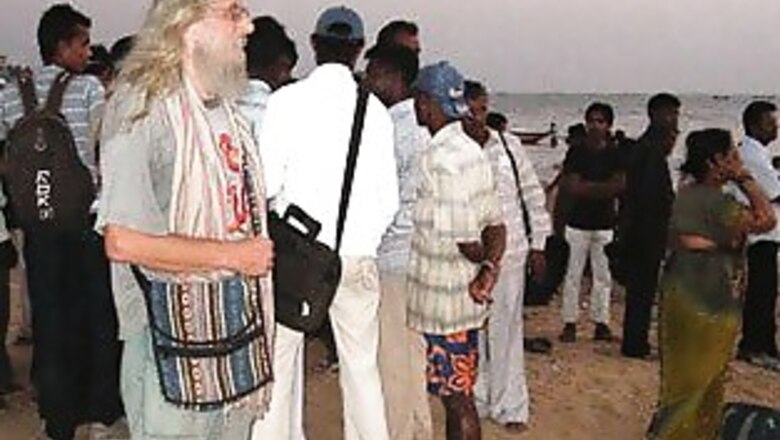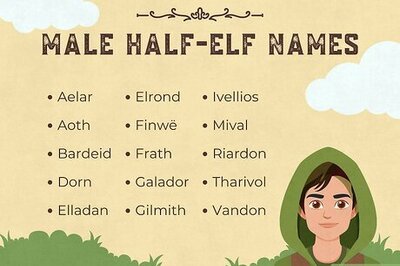
views
Jan van Djik looks weather beaten. It looks as if he spent a good part of his 67 years strolling on Calangute beach. The Dutchman has been following a 20-year ritual of visiting Goa twice a year. Except that over the last few years, he has been spending less and less time there. “Doing a lot of travel in other parts, especially in the North… Benares.”
It was travellers like Djik who made Goa the destination that it is. Tourists from sun-starved European countries escaped to Goa to avoid the brutal winter. Sipping beer, smoking marijuana or just playing a game of beach cricket, they bankrolled Goa’s tourism economy. The hotels, beach shacks, restaurants, two-wheeler hire guys, all made money.
But today it has all spun out of control. Goa is seeing a sharp drop in foreign tourist arrivals compared to other popular Indian destinations like Agra, Jaipur and Kerala. It is also fast losing its billing as an international tourist haven. Most of its competitors, like Bali in Indonesia and Langkawi in Malaysia, have shown impressive growth in 2009. Even upcoming options like Sri Lanka and Vietnam are getting more feelers from European tourists, industry players say (see graphic).
Goa used to get one out of five foreign tourists coming to India. But the 2009 winter season (the peak season, traditionally from October to March) has seen the second consecutive drop in incoming foreign tourists after the dramatic plummet in 2008 — something that the local industry says has happened for the first time.
“This year it looks like the season has got over by mid-January,” says Cruz Cardozo, president of the Goa Shack Owners Association. Various estimates put the total overseas tourist arrivals in 2009 at 300,000, down from about 350,000 a year earlier and about 380,000 in 2007.
Sure, other popular Indian destinations, too, have suffered, but Goa has suffered more. According to tourism ministry, arrivals to India fell by 3.3 percent in 2009. That is marginal compared to Goa government’s official figure of a 13 percent drop; the local industry estimates a more than a 30 percent dip.
Home truths
While the foreigners stay away, Indians have been coming in--industry veterans say the 2002 blockbuster Dil Chahta Hai, partly set in Goa, was a major influence in making the place fashionable for Indians. Bollywood film stars and industrialists who bought property in the state as a status symbol also had something to do with it.
This has “saved the Goan tourism industry in the last two years”, Viveck Pathiyan, general manager at Hotel Fidalgo in capital Panjim, says. The hotel’s clientele has changed dramatically, with Indians now constituting 80 percent of the guests, up from just about 30 percent earlier.
Yet Indian tourists aren’t a big enough cushion to absorb the fall in overseas guests. On average, overseas travellers stay for almost two weeks; Indian holidays last for just about three days, says Ralph De Souza, president, Travel and Tourism Association of Goa. Hence, the tourism season in Goa lasts for only six months, coinciding with the stay of overseas guests.
Goa got only about 10 lakh Indian tourists in 2009. Agra and Kerala get anything from 3 lakh to 10 lakh foreign visitors every year, but they also get more domestic tourists. Agra gets 2 crore of them, Jaipur 1 crore and Kerala about 60 lakh.
“Indians spend well. Once a group of youngsters came and spent Rs. 14,000 on shots in just a couple of hours,” says Ainsley Kelly, owner of Shooters, a pub near Baga beach. “But our bread and butter are the foreign tourists who come everyday, sit around, drink a beer or two, eat and then go off. That is why this year, business has not been that good.”
The truth is, Goa needs the foreign tourists.
The state’s tourism business is mostly family-owned and operated out of homes, and the drop in overseas holidaymakers is affecting them. Take Jerry’s Corner, a small eatery near Calangute beach that doubles up as a hotel with rooms on top. It used to get 10 European couples every year. “They would stay up to six months. But only six have turned up this season and they will be here for half of the usual time,” says Jerry, the owner. “Sure, the Indians come, but they are here just over the weekend… it is not the same.” He says.
Goa has tried to lure more Indians by transforming itself into a year-round destination, with ‘monsoon holidays’ for couples. These moves have not succeeded. “Goa, without the foreigners, will not be Goa anymore. And even the Indians will stop coming,” says an official, who heads the local business of a leading travel company and wishes to be unnamed.
How the Cookie Crumbled
Outsiders have for long influenced the way of life in Goa. First it was the Portuguese who ruled the state for 450 years till 1961. Almost immediately after that, hippies from Europe discovered Goa.
PAGE_BREAK
“We have always been comfortable with outsiders. We were used to seeing bikini-clad foreigners shopping or sunbathing in the buff on the beach. Though Goans also enjoy life, there is a clear line of separation,” says a local media veteran who requested not to be named.
Sadly, that separation has increasingly blurred in recent years as more and more Goans find themselves facing the ramifications of unregulated, uncontrolled tourism that they themselves had unwittingly fuelled.
Over the years, Goa as a tourist destination was increasingly seen as a place where “you can leave your guilt behind at the moment when you travel and indulge in your wildest fantasies”. It didn’t help that the administration gave tacit support--in 1993, at the Berlin Tourism Fair, a Government of India audio-visual depicted two beaches in Goa sandwiched between the erect nipples of a white woman’s breasts. It is not just incidental that India’s first case of paedophilia was registered in Goa in the 1990s or that the state has become a centre for global drug trafficking.
“Tourism in Goa is now being developed on the basis of women, wine, drugs and the latest entrant, gambling. Thus, it is now attracting the wrong kind of crowd as tourists,” says social activist Sabina Martins. Surely, that creates conflict within the local community that is dependent on the tourism business, but doesn’t like the new corrupting influences.
Then there’s the issue of more and more of the real estate coming under the control of non-Goans.
As foreign tourists poured in, their stay became longer and some decided not to go back --like the Russians in Morjim, north Goa. In the last five years, affluent Indians have also started buying “second homes” in the state, fuelling a real estate boom. Flat prices rose from Rs. 800 per sq. ft. to over Rs. 8,000 even in far-off places within just five years. The result? While initially the locals prospered by selling their lands, the ill-effects followed soon.
Goa has become a hotbed of conflict “with about 20 of the 189 villages always on the boil at any point of time due to various issues including new construction encroaching on forest or agriculture land and swimming pools of the rich outsiders consuming water meant for locals. Worse, basic amenities like hygiene, shelter and water is going out of reach for the locals,” says Martins.
Done in by Greed
The “death of Goa as a destination,” as Sujay Gupta puts it (he is writing a book on the drugs trade in Goa), was caused by “the local travel industry’s carelessness, fuelled by a government that has been rudderless and without vision.”
Arjun Sharma, managing director, Le Passage to India, which specialises in getting foreign tourists to the country, agrees. “Goa as a destination has always attracted the charter tourist, who comes with a group of other travellers and spends about 300 to 500 pounds for a two-week stay. Though charter tourists have reduced as a percentage of the total, Goa is still more popular among the ‘cost conscious traveller’, unlike Kerala that has positioned itself as a high-value destination,” he says.
But the local industry, intoxicated by the boom days, forgot this significant reality. Though its offering remained the same — sunny weather coupled with beaches that had low-cost shacks filled with fenny, beer and fish — the price tags only got heavier. “The local industry has been pennywise and pound foolish,” says Fidalgo’s Pathiyan. “We should have tariffs that are sustainable in the long-run and not look for immediate gains,” he says of the hotel industry that was used to charging as much as eight times the “normal” tariffs during the peak season.
Visa is a pain point too. In the last few years, stricter visa regulations have also had unintended consequences for Goa tourism. A Swedish tour operator for Goa says, on conditions of anonymity, that it takes almost two months to get a visa for someone from Sweden to come to Goa, whereas in Phuket (Indonesia), Vietnam and Malaysia, one gets visa on arrival. “It is not surprising that almost 26 charter planes from Scandinavian countries are coming to Phuket every week. Earlier, they used to come to Goa,” she says. Along with still-expensive hotels, even after tariffs were cut once the slowdown set in, visa expenses make holidays in Goa costlier by 600 euros or 500 pounds.
Industry veterans also blame poor marketing as one of the reasons Goa is losing its shine.
PAGE_BREAK
A complacent state administration has meant that other tourism-heavy states like Rajasthan and Kerala, or countries like Thailand, have stolen a march over Goa. With more options coming up, tourists gave Goa a miss. “Thailand tourism has 40 billboards all around Moscow and Goa has three,” says a Russian tour operator in Goa who didn’t want to be named.
Adds his Indian friend, also from the industry: “How much of Goa is featured in the Incredible India campaign? It is instead full of Rajasthan tourism… we don’t even have anything close to Kerala’s God’s Own Country marketing initiative.”
Can Goa Reinvent Itself?
Ironically, tourism might still be Goa’s best bet as it constitutes about 35 percent of the economy and employs close to 40 percent of the working population. Though mining is another major constituent (almost 30 percent) of its economy, “in the long run only tourism can provide livelihood to Goans as natural resources are finite,” says Nitin Kunkolienkar, former president of Goa Chamber of Commerce and Industry. But he adds, “Tourism has to be clean and Goa has to become a family destination to attract more tourists.”
For that, Goa might have to go beyond its sun-and-beach offering. It doesn’t have to look too far for inspiration. Bali, Phuket and even Langkawi in Malaysia are other popular sun and beach destinations in the region. But each of them has taken a step ahead to build more attractions like cable cars, shark sanctuaries and nocturnal zoos. “Like in these places, Goa too needs a viable partnership between private enterprises and the government and both need to be forthright in their endeavour,” says P. Manoharan, Director, Tourism Malaysia.
Lyndon Monteiro, Officer on Special Duty, Ministry for Tourism, Goa, admits that “there are challenges but one should understand that we are working under a lot of constraints.” One of those constraints would be the budget. According to industry estimates, while Kerala government spends more than Rs. 50 crore just on ad campaigns to promote tourism in the state, Goa’s entire budget for promotion is less than Rs. 20 crore. It is not surprising when Monteiro says that “we first want to develop Goa as a destination with a proper infrastructure before promoting it.”
But the question, like Pascal Dupuis, General Manager at The Leela Kempinksi, puts it, is: “Goa is a “$250 destination (in terms of hotel tariff). The question is, does Goa have in it to become a $500 destination, say like Mauritius?” The answer to that would decide if the Djiks will rediscover their love for Goa or not.
(Edited by Sveta Basraon)



















Comments
0 comment